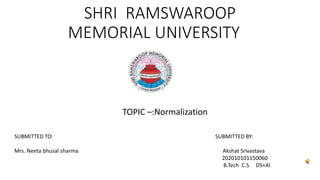normalization-1.pptx
•Download as PPTX, PDF•
0 likes•53 views
normalization
Report
Share
Report
Share

Recommended
Recommended
More Related Content
Similar to normalization-1.pptx
Similar to normalization-1.pptx (20)
CIS 515 discussion post responses.There are two discussions he.docx

CIS 515 discussion post responses.There are two discussions he.docx
Introduction to Database Management Systems (DBMS)

Introduction to Database Management Systems (DBMS)
Advantages and disadvantages of relational databases

Advantages and disadvantages of relational databases
Recently uploaded
From customer value engagements to hands-on production support, our Services span across every stage of our customers digital transformation journey, to help ensure that every customer is successful in their adoption of our solutions.
• Implementation, Upgrade, Migration, and Maintenance Services
• On-Premises and On-Cloud
• COTS Training Services; On-Site and Virtual
• Software Support Services; Legacy and 3DEXPERIENCE
• Value Engagement & Blueprinting
• Specialized Consulting and Support Services
• Customized Training Services
• Automation and Configuration Services
• Technical Resource Augmentation Services
• Project Management
• Know-how Training (mentoring) and Resource AugmentationNavigating Complexity: The Role of Trusted Partners and VIAS3D in Dassault Sy...

Navigating Complexity: The Role of Trusted Partners and VIAS3D in Dassault Sy...Arindam Chakraborty, Ph.D., P.E. (CA, TX)
Recently uploaded (20)
S1S2 B.Arch MGU - HOA1&2 Module 3 -Temple Architecture of Kerala.pptx

S1S2 B.Arch MGU - HOA1&2 Module 3 -Temple Architecture of Kerala.pptx
Navigating Complexity: The Role of Trusted Partners and VIAS3D in Dassault Sy...

Navigating Complexity: The Role of Trusted Partners and VIAS3D in Dassault Sy...
NO1 Top No1 Amil Baba In Azad Kashmir, Kashmir Black Magic Specialist Expert ...

NO1 Top No1 Amil Baba In Azad Kashmir, Kashmir Black Magic Specialist Expert ...
Double Revolving field theory-how the rotor develops torque

Double Revolving field theory-how the rotor develops torque
Unit 4_Part 1 CSE2001 Exception Handling and Function Template and Class Temp...

Unit 4_Part 1 CSE2001 Exception Handling and Function Template and Class Temp...
Block diagram reduction techniques in control systems.ppt

Block diagram reduction techniques in control systems.ppt
HOA1&2 - Module 3 - PREHISTORCI ARCHITECTURE OF KERALA.pptx

HOA1&2 - Module 3 - PREHISTORCI ARCHITECTURE OF KERALA.pptx
PE 459 LECTURE 2- natural gas basic concepts and properties

PE 459 LECTURE 2- natural gas basic concepts and properties
1_Introduction + EAM Vocabulary + how to navigate in EAM.pdf

1_Introduction + EAM Vocabulary + how to navigate in EAM.pdf
"Lesotho Leaps Forward: A Chronicle of Transformative Developments"

"Lesotho Leaps Forward: A Chronicle of Transformative Developments"
normalization-1.pptx
- 1. SHRI RAMSWAROOP MEMORIAL UNIVERSITY TOPIC –:Normalization SUBMITTED TO: SUBMITTED BY: Mrs. Neeta bhusal sharma Akshat Srivastava 202010101150060 B.Tech C.S DS+AI
- 2. What is Normalization? • Normalization is the process of organizing the data in the database. • Normalization is used to minimize the redundancy from a relation or set of relations. It is also used to eliminate undesirable characteristics like Insertion, Update, and Deletion Anomalies. • Normalization divides the larger table into smaller and links them using relationships. • The normal form is used to reduce redundancy from the database table.
- 3. Why do we need Normalization? • The main reason for normalizing the relations is removing these anomalies. • Failure to eliminate anomalies leads to data redundancy and can cause data integrity and other problems as the database grows. • Normalization consists of a series of guidelines that helps to guide you in creating a good database structure.
- 4. Data modification anomalies can be categorized into three types: Insertion Anomaly: Insertion Anomaly refers to when one cannot insert a new tuple into a relationship due to lack of data.
- 5. • Deletion Anomaly: The delete anomaly refers to the situation where the deletion of data results in the unintended loss of some other important data.
- 6. • Updatation Anomaly: The update anomaly is when an update of a single data value requires multiple rows of data to be updated.
- 7. Advantages of Normalization • Normalization helps to minimize data redundancy. • Greater overall database organization. • Data consistency within the database. • Much more flexible database design. • Enforces the concept of relational integrity.
- 8. Disadvantages of Normalization • You cannot start building the database before knowing what the user needs. • It is very time-consuming and difficult to normalize relations of a higher degree. • Careless decomposition may lead to a bad database design, leading to serious problems.
- 9. First Normal Form (1NF) • A relation will be 1NF if it contains an atomic value. • It states that an attribute of a table cannot hold multiple values. It must hold only single-valued attribute. • First normal form disallows the multi-valued attribute, composite attribute, and their combinations. EMPLOYEE table:
- 10. Second Normal Form (2NF) • In the 2NF, relational must be in 1NF. • In the second normal form, all non-key attributes are fully functional dependent on the primary key
- 11. Third Normal Form (3NF) • A relation will be in 3NF if it is in 2NF and not contain any transitive partial dependency. • 3NF is used to reduce the data duplication. It is also used to achieve the data integrity. • If there is no transitive dependency for non-prime attributes, then the relation must be in third normal form.
- 12. Thank you